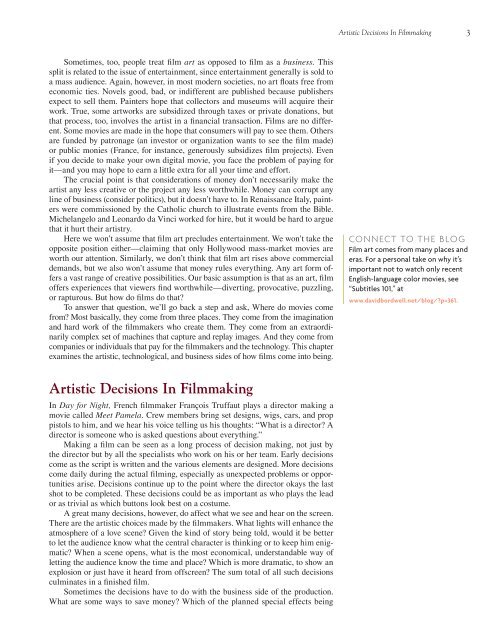Film Art and Filmmaking
Film Art and Filmmaking
Film Art and Filmmaking
Create successful ePaper yourself
Turn your PDF publications into a flip-book with our unique Google optimized e-Paper software.
Sometimes, too, people treat fi lm art as opposed to fi lm as a business. This<br />
split is related to the issue of entertainment, since entertainment generally is sold to<br />
a mass audience. Again, however, in most modern societies, no art fl oats free from<br />
economic ties. Novels good, bad, or indifferent are published because publishers<br />
expect to sell them. Painters hope that collectors <strong>and</strong> museums will acquire their<br />
work. True, some artworks are subsidized through taxes or private donations, but<br />
that process, too, involves the artist in a fi nancial transaction. <strong>Film</strong>s are no different.<br />
Some movies are made in the hope that consumers will pay to see them. Others<br />
are funded by patronage (an investor or organization wants to see the fi lm made)<br />
or public monies (France, for instance, generously subsidizes fi lm projects). Even<br />
if you decide to make your own digital movie, you face the problem of paying for<br />
it—<strong>and</strong> you may hope to earn a little extra for all your time <strong>and</strong> effort.<br />
The crucial point is that considerations of money don’t necessarily make the<br />
artist any less creative or the project any less worthwhile. Money can corrupt any<br />
line of business (consider politics), but it doesn’t have to. In Renaissance Italy, painters<br />
were commissioned by the Catholic church to illustrate events from the Bible.<br />
Michelangelo <strong>and</strong> Leonardo da Vinci worked for hire, but it would be hard to argue<br />
that it hurt their artistry.<br />
Here we won’t assume that fi lm art precludes entertainment. We won’t take the<br />
opposite position either—claiming that only Hollywood mass-market movies are<br />
worth our attention. Similarly, we don’t think that fi lm art rises above commercial<br />
dem<strong>and</strong>s, but we also won’t assume that money rules everything. Any art form offers<br />
a vast range of creative possibilities. Our basic assumption is that as an art, fi lm<br />
offers experiences that viewers fi nd worthwhile—diverting, provocative, puzzling,<br />
or rapturous. But how do fi lms do that?<br />
To answer that question, we’ll go back a step <strong>and</strong> ask, Where do movies come<br />
from? Most basically, they come from three places. They come from the imagination<br />
<strong>and</strong> hard work of the fi lmmakers who create them. They come from an extraordinarily<br />
complex set of machines that capture <strong>and</strong> replay images. And they come from<br />
companies or individuals that pay for the fi lmmakers <strong>and</strong> the technology. This chapter<br />
examines the artistic, technological, <strong>and</strong> business sides of how fi lms come into being.<br />
<strong>Art</strong>istic Decisions In <strong>Film</strong>making<br />
In Day for Night, French fi lmmaker François Truffaut plays a director making a<br />
movie called Meet Pamela. Crew members bring set designs, wigs, cars, <strong>and</strong> prop<br />
pistols to him, <strong>and</strong> we hear his voice telling us his thoughts: “What is a director? A<br />
director is someone who is asked questions about everything.”<br />
Making a fi lm can be seen as a long process of decision making, not just by<br />
the director but by all the specialists who work on his or her team. Early decisions<br />
come as the script is written <strong>and</strong> the various elements are designed. More decisions<br />
come daily during the actual fi lming, especially as unexpected problems or opportunities<br />
arise. Decisions continue up to the point where the director okays the last<br />
shot to be completed. These decisions could be as important as who plays the lead<br />
or as trivial as which buttons look best on a costume.<br />
A great many decisions, however, do affect what we see <strong>and</strong> hear on the screen.<br />
There are the artistic choices made by the fi lmmakers. What lights will enhance the<br />
atmosphere of a love scene? Given the kind of story being told, would it be better<br />
to let the audience know what the central character is thinking or to keep him enigmatic?<br />
When a scene opens, what is the most economical, underst<strong>and</strong>able way of<br />
letting the audience know the time <strong>and</strong> place? Which is more dramatic, to show an<br />
explosion or just have it heard from offscreen? The sum total of all such decisions<br />
culminates in a fi nished fi lm.<br />
Sometimes the decisions have to do with the business side of the production.<br />
What are some ways to save money? Which of the planned special effects being<br />
<strong>Art</strong>istic Decisions In <strong>Film</strong>making<br />
CONNECT TO THE BLOG<br />
<strong>Film</strong> art comes from many places <strong>and</strong><br />
eras. For a personal take on why it’s<br />
important not to watch only recent<br />
English-language color movies, see<br />
“Subtitles 101,” at<br />
www.davidbordwell.net/blog/?p=361.<br />
3

















